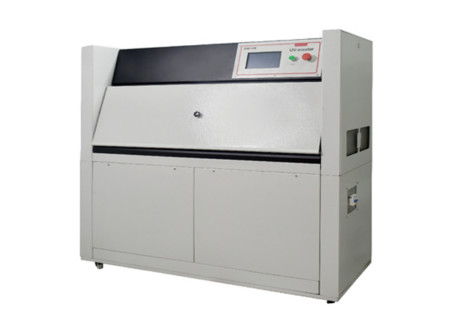Site: Home > Home > News and events
Why use UV Accelerated Weathering Tester for photoaging experiments? In our life, some products are inevitably exposed to light, such as exterior wall coatings, plastics, textiles, etc. Ultraviolet rays in sunlight, coupled with high temperature, rain and dew and other conditions, will cause product strength reduction, cracking, peeling, dullness, discoloration, chalking and other aging phenomena.
So, how can we prevent this? First of all, we believe that before the product is put into use on a large scale, photoaging experiments should be carried out to evaluate its aging resistance. However, if it is naturally aged, it may take several years or even longer to see results, which is obviously not in line with actual production. Moreover, the climatic conditions in different places are different, and the same test material needs to be tested in different places, so the test cost is greatly increased.
Laboratory photoaging tests can not only shorten the cycle, but also have good repeatability. Wide range of applications, the whole process is completed in the laboratory, no need to consider regional restrictions, simple operation and strong controllability.

Simulate the real lighting environment and use the method of artificial accelerated photoaging to quickly evaluate the performance of the material. The main methods are ultraviolet aging test, xenon lamp aging test and carbon arc aging.
1. Ultraviolet aging test. Ultraviolet wavelengths are usually between 290nm and 400nm to better simulate sunlight in the short-wave ultraviolet band. Short-wave UV tends to cause polymer aging such as loss of strength, loss of gloss, yellowing, embrittlement and cracking. Moreover, the spectrum of the short-wave ultraviolet light tube is stable, and the spectral power distribution is not affected by time, which can improve the authenticity and repeatability of the test. The UV aging test chamber can also simulate outdoor humidity, which can cause bubbles, cracks and corrosion to the coating surface through deep penetration.
2. The xenon lamp mainly simulates sunlight, and the wavelength is generally between 400nm-800nm. Different from the UV aging test, the xenon lamp simulates the long-wave ultraviolet and visible light bands better. Long-wave UV waves and visible light can cause fading and color change of pigments and dyes, so the test focused on xenon lamps.
3. Carbon arc lamp aging is the earliest aging test method, but due to the high maintenance cost of the test chamber, the shortcoming of being unable to simulate a narrow spectral range has been gradually eliminated.
How many times is the accelerated aging in the laboratory compared to the actual natural conditions?
People often wonder how fast labs can accelerate aging. Can a lab do a year of aging in a month? In fact, there is currently no clear standard or research paper pointing to a formula for the laboratory to speed up the aging test. The main reason is that there are too many changing factors under natural conditions, such as light time, light intensity, temperature and humidity, rainfall and even pollutants, which will affect the aging process. It is impossible to simulate completely in the laboratory. Therefore, most standards do not give test times. Time is often the result of multi-party negotiation.
Of course, some standards give time, but this is also a comparison of laboratory data with long-term usage data. Enterprises choose the corresponding testing standards, as long as the testing is carried out strictly in accordance with the testing requirements, the actual data can meet the production needs.
If you are interested in UV Accelerated Weathering Tester, please leave us a message!
Copyright 2022:Qinsun Instruments Co., Limited
High-end textile tester supplier Email:info@qinsun-lab.com | Textile Testing Equipment pdf | Tel:021-67800179 |